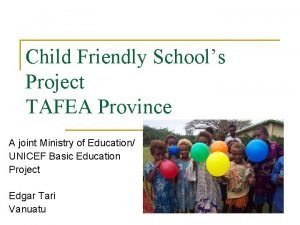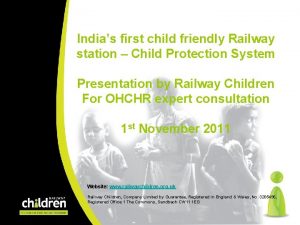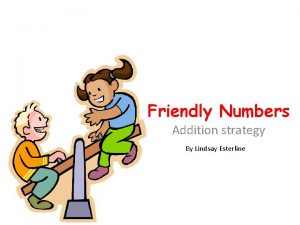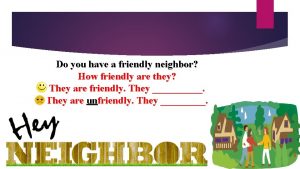Child Friendly Place Workshop on Design Place for





















- Slides: 21

Child Friendly Place Workshop on Design Place for Children in Solo, Java Universitas Muhammadiyah Surakarta 5 August 2009 Learning outcome: To explore the qualities of child friendly place in city of Solo Ismail Said Dept of Landscape Architecture Universiti Teknologi Malaysia 1

Problems in Cities for Children • Cities are home to an increasing proportion of the world’s children. • Yet, most cities are largely unfriendly to children. • Six out of ten children will live in urban areas in lowand middle-income nations by 2025. • Despite the growing proportion of the world’s children living in urban areas, most city authorities remain ill-equipped to make their cities more child friendly. • Children are losing the ability to travel on their own or explore green spaces. 2

Why we need to develop child friendly city? • Towns and cities have rich affordances which, through children’s exploration, contribute to their repertoires of widening social and cognitive worlds (Chatterjee , 2005). • Cities are places where children’s right to a healthy, caring, protective, educative, stimulating, non-discriminating, inclusive, culturally rich environment are addressed (Riggio 2002, 45). 3

Child Friendly City • The CFC thus has the promise of making the world a better place for many children. • Implementation of the Convention on the Rights of the Child may provide the right of every child to: – Meet friends and play – Have green spaces for plants and animals – Walk safely in the streets on their own – Express their opinion on the city they want – Participate in family, community and social life 4

Convention on the Rights of the Child • Respecting children’s views (Article 12): a child friendly city promotes the active participation of children, ensuring children’s freedom to express their views and that their views are given due weight in all matters affecting them. • It does not treat children in isolation from the larger political and decision-making process. On the contrary, it integrates their concerns into the larger city managementand planning process (Eliana Riggio, 2002). • Introduce an integrated system of green spaces and play areas into the old city area. 5

Children play beside a railway line where their families have set up makeshift homes. Imagination Playground 6

Play in Cities • Play is an instinctive and essential part of childhood. • Play allows children to work out their emotions. • But, design of modern cities has left fewer spaces for play. Children play in a flooded street in Mumbai. Millions of people were upset by the disaster. It's difficult for the children, but they are learning to have fun again 7

The Benefits of Play • Play is essential to development as it contributes to the cognitive, physical, social, and emotional wellbeing of children and youth. • Play allows children to use their creativity while developing their imagination, dexterity, and physical, cognitive, and emotional strength. • As they master their world, play helps children develop new competencies that lead to enhanced confidence and the resiliency they will need to face future challenges. 8

Sense of Place • A sense of place conveys a way in which the setting instills itself in the child. • SOP consists of three phases: the first phase is belonging to a place, the middle phase is attachment, and the third (and most intense) phase is commitment to a place (Shamai 1991). • Through regularly playing outdoors in attractive, engaging environments children form emotional and meaningful bonds with place, which in turn has positive effects on self identity and esteem. 9

Sense of Control Children playing football in Mozambique 10

Place attachment and Friendship • Chawla (1992) notes “children are attached to a place when they show happiness at being in it and regret or distress at leaving it, and when they value it not only for the satisfaction of physical needs but for its intrinsic qualities” (p. 64). • Children should be able to form friendship with place just as they are attached to favorite places 11

Friendship • Friendship is a process of mutual selection by which a child chooses and is simultaneously chosen by another as a preferred friend (Doll 1996). The essentials of friendship, according to Hartrup (1991) are reciprocity and commitment between individuals who perceive each other as more or less equal 12

Friendship Six essential elements across the developmental range of childhood (Doll, 1996): 1. Mutual affection and personal regard, by which each friend demonstrates a caring responsibility for the other (Hinde 1979) 2. Shared interests and activities, representing the friends’ investment of time and intention to have fun together (Hartrup 1989 a; Youngiss 1980) 3. Commitment, or the intention on the part of both friends to continue fostering the relationship over time (Asher 1995; Hartrup 1989 a; Hinde et al. 1985) 4. Loyalty, that is the intention of both friends to protect the interest of the other (Hartrup 1989 a; Hinde 1979) 5. Self-disclosure and mutual understanding, by which each friend acquires and contributes to an uncommon understanding of the other (Hartrup 1989 a) 6. Horizontality, such that friends share power in the relationship (Hartrup 1989 a; Hinde 1979) 13

Place Friendship • Children share affective relationships with favorite places that cater to a range of developing friendship needs and ideologies. Children play at an evacuation camp in Datu Piang town in southern Philippines' Maguindanao province July 2, 2009. Internally displaced children, who fled a military offensive in the Swat valley region, play on a seesaw at the UNHCR (United Nations High Commission for Refugees) Yar Hussain camp in Swabi district, located about 120 km (75 miles) northwest of Pakistan's capital Islamabad on June 30, 2009. 14

Affordances • Affordances are unique to the individual playing child, or group of children, and are to some extent unpredictable. Children play in response to both the objective and subjective qualities of an environment. • Affordances are highly dynamic - different features/elements/materials affording different play experiences for different individuals on different occasions. • The number of affordances increases with complexity of the environment. • Through manipulating and changing flexible environments through their play, children detect new affordances. 15

Children displaced by war play on a tree near the town of Gos Beida in eastern Chad Children play on a destroyed Russian tank in the stronghold of Panjwaii in Kandahar province, southern Afghanistan, April 10, 2009 16

Tool, artifact and representation • Meaningful features of the environment include not only affordances but also tools, artifacts and representations. • A tool is found in the environment and is selected for its possibilities for extending and aiding action. An artifact is a tool that has been designed to carry out various tasks. The knowledge stored in artifacts is more than just how they are used as implements. It also includes knowledge of aspects of daily life, techniques, social history, and rituals. 17

Tool, artifact and representation • Representations create possibilities of storing knowledge in the inanimate environment. Representations allow information to be publicly available in a more self-conscious attempt to shape the future of humankind. In the context of child-friendly environments, found tools (naturally-occurring places and attributes) and artifacts (specially designed places and attributes) have potential affordances which, when actualized by children, will result in place knowledge. Constructions by children in the environment such as dens, pondok, and play forts, and other conscious attempts to define special places, such as graffiti and inscriptions, provide representations of their territories. 18

Friendly Place • Children are attached to favorite places because they get relaxation, feeling calm, and clearing their minds (Korpela, 1992). • The places also provide beauty, sense of control, security, freedom of expression and escape from social pressures. 19

Qualities of Friendly Place • In order for the child to prefer that specific place to others, the place has the responsibility to satisfy those needs, to create a fit between action and the environmental features affording those actions. • Key qualities for children’s friendly place (Wilson, 2007; Chatterjee, 2006) : – – – – Accessible Inviting Stimulating Flexible Challenging Comfortable Supporting 20

Summary • A child-friendly place is an environment that promotes exploration and actualization of its many affordances for different activities and social interactions; offers opportunities for environmental learning and competence by shaping physical characteristics of the place through repeated use and promoting children’s participation in care and maintenance of the place; allows children to express themselves freely in creation and control of territories and special places; and protects the secrets and activities of children in these childhood places from harm (Chatterjee, 2006). Inventive freedom and contact with living things have always been at the heart of emotional memory 21
 Child-friendly school activities
Child-friendly school activities Child friendly school
Child friendly school Child friendly school
Child friendly school Left child right sibling tree
Left child right sibling tree Kontinuitetshantering i praktiken
Kontinuitetshantering i praktiken Typiska drag för en novell
Typiska drag för en novell Nationell inriktning för artificiell intelligens
Nationell inriktning för artificiell intelligens Returpilarna
Returpilarna Varför kallas perioden 1918-1939 för mellankrigstiden
Varför kallas perioden 1918-1939 för mellankrigstiden En lathund för arbete med kontinuitetshantering
En lathund för arbete med kontinuitetshantering Underlag för särskild löneskatt på pensionskostnader
Underlag för särskild löneskatt på pensionskostnader Tidböcker
Tidböcker A gastrica
A gastrica Vad är densitet
Vad är densitet Datorkunskap för nybörjare
Datorkunskap för nybörjare Tack för att ni lyssnade bild
Tack för att ni lyssnade bild Debattinlägg mall
Debattinlägg mall Delegerande ledarstil
Delegerande ledarstil Nyckelkompetenser för livslångt lärande
Nyckelkompetenser för livslångt lärande Påbyggnader för flakfordon
Påbyggnader för flakfordon Vätsketryck formel
Vätsketryck formel Svenskt ramverk för digital samverkan
Svenskt ramverk för digital samverkan









































